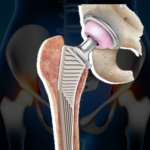
The hip joint is crucial in the body that allows for movement, stability, and support. However, like any other joint, it can be susceptible to problems, including injury, arthritis, and degeneration. In this blog post, we will discuss the diagnosis and treatment of hip problems.
Diagnosis of hip problems:
To diagnose hip problems, your doctor will begin with a physical examination and medical history. This may include assessing your range of motion, strength, and stability, as well as evaluating your gait and posture. Diagnostic tests such as X-rays, MRI, and CT scans may also be recommended to evaluate the underlying cause of hip pain and dysfunction.
Some common hip problems and their diagnosis are:
- Osteoarthritis: This is diagnosed through a combination of physical examination, imaging tests, and medical history.
- Hip fractures: These are typically diagnosed with an X-ray or CT scan.
- Bursitis: This is diagnosed based on the physical examination and medical history, along with imaging tests such as ultrasound or MRI.
Treatment of hip problems:
The treatment for hip problems will depend on the underlying cause and severity of the condition. Non-surgical treatments are typically recommended as the first line of treatment, while surgery may be necessary in more severe cases.
Non-surgical treatments:
Rest and activity modification: Rest and limiting activities that aggravate hip pain can help reduce symptoms and promote healing.
- Physical therapy: This can help improve range of motion, strength, and stability, as well as reduce pain and inflammation.
- Medications: Over-the-counter pain relievers, such as acetaminophen or nonsteroidal anti-inflammatory drugs (NSAIDs), can help manage pain and inflammation.
- Injections: Corticosteroid injections can help reduce inflammation and pain.
Surgical treatments:
- Hip arthroscopy: This minimally invasive procedure uses a small camera and instruments to repair torn cartilage, remove bone spurs, or treat other conditions in the hip joint.
- Hip resurfacing: This procedure involves removing damaged or arthritic bone and capping the joint with a metal shell to allow for smoother movement.
- Hip replacement: This procedure involves removing the damaged or arthritic joint and replacing it with a prosthetic joint.
Rehabilitation and recovery:
After any treatment for hip problems, rehabilitation is important to promote healing, restore function, and reduce the risk of future problems. This typically includes physical therapy, exercises, and lifestyle modifications.
In conclusion, hip problems can be diagnosed through a combination of physical examination, medical history, and imaging tests. Treatment options include non-surgical and surgical treatments, depending on the underlying cause and severity of the condition. Rehabilitation and recovery are important for restoring function and reducing the risk of future problems. If you are experiencing hip pain or other symptoms, talk to your doctor or a qualified healthcare professional for an accurate diagnosis and appropriate treatment plan.




